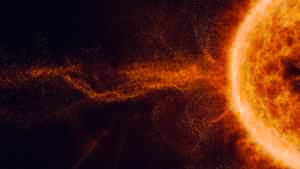Each of the planets in our planetary group is held within an attractive pocket of air, interrupted by the sun-directed breeze, the constantly flowing material of the Sun. This attractive pocket of air, called the heliosphere, protects planets from harmful infinite radiation that is dispersed after unpredictable powerful events such as supernovas. Outside the heliosphere, there is the interstellar medium, ionized gas, and attractive field that fills the space between the star frames in our cosmic system. The state of this attractive air pocket is one that researchers have been trying to grapple with for years with serious consequences.
Up to this point, the heliosphere was felt to be molded like a comet with a set driving edge called the "nose" and a long tail at the rear. A new review, published this spring in Nature Stargazing and highlighted in the July front of the diary, offers us a selective shape: a decadent croissant. It is difficult to judge the state of the heliosphere from the inside. The nearest edge of the heliosphere exceeds ten billion kilometers from Earth. Only two Explorer rockets had the option to measure this locale directly, leaving us with precise reference information about the state of the heliosphere.
Our frontier in interstellar space is intensified by catching and noticing particles flying towards Earth by different satellites and surveillance vehicles in space. Some of these particles are charged particles from distant regions of the universe called cosmic majestic rays, often found in our nearby group of planets, charged particles that move toward the solstice and return to Earth through an astonishing series of electromagnetic cycles. These are called fiery neutral molecules and are a guide for planning the edge of the heliosphere, as they are formed by connecting with the interstellar medium. NASA's Interstellar Limit Pioneer (IBEX) mission focuses on the heliosphere and uses these particles as a type of radar. Thus, it follows the boundary of our group of planets near interstellar space. Researchers are using computer models to understand this mind-blowing information and turn it into an indicator of the properties of the heliosphere. Merav Opher, lead creator of the new NASA and NSF-funded research, chairs the Boston College DRIVE Science Center. The final cycle of the Opher model uses information from NASA planetary science missions to describe the way the material that fills the attractive air pocket of the heliosphere behaves in space and to gain another perspective on its limits.
While NASA's Cassini mission carried an instrument aimed at concentrating particles captured in Saturn's attractive field, it was also citing the observable facts that the particles were returning to the nearby group of planets inside. These estimates were similar to those of the Interstellar Space Explorer, but gave an alternative perspective on the boundary of the heliosphere.
Likewise, NASA's New Skylines mission has allowed us to learn about a unique type of particle called "particles" that ionize in space and collect in the sunlight-based breeze. These particles are much more sizzling than sun-directed breeze particles emanating from the Sun due to various starting points. Opher, a cosmology teacher at Boston College, put his work together on these parts.
Independently accounting for parts of the sun-directed breeze, Opher's previous work, which included the attractive field of the sun as the dominant force in molding the heliosphere, made a pale, long-tracked croissant shape framed by the bending of two fly streams out of focus. part of the heliosphere.
Researchers see an empty croissant. We are a delicious shrimp. So what do you see?
Why Does the Shape of the Heliosphere Matter?
The state of the heliosphere is too strange for mainstream researchers. The heliosphere acts as a shield that protects our planetary group from the rest of the world. States in other stellar frameworks, such as supernovae, can accelerate particles to nearly the speed of light. These particles are tossed back and forth, including our planetary group. However, the heliosphere acts as a shield, enclosing about 3/4 of these gigantic living particles called vast beams that will enter our Planetary group.
On the planet, we are protected by the attractive space and weather of our planet, but space explorers and our satellites in space are practically helpless. Both electronic devices and human cells can be damaged by the impact of cosmic immeasurable rays. Because these rays carry so much energy, it's undeniable that they will stay away from the foundation on upcoming space travel. The heliosphere is space travelers' primary protection against cosmic majestic rays, so understanding its shape is an important consideration for orchestrating mechanical and tracked space exploration.
Likewise, as you continue to search for life in different universes, the state of the heliosphere will be important to the puzzle. Harmful radia from cosmic broad rays








0 Comments